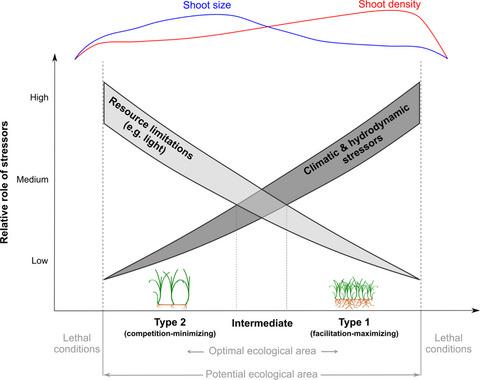Our official English website, www.x-mol.net, welcomes your
feedback! (Note: you will need to create a separate account there.)
Drivers and limits of phenotypic responses in vulnerable seagrass populations: Zostera marina in the intertidal
Journal of Ecology ( IF 5.3 ) Pub Date : 2021-10-07 , DOI: 10.1111/1365-2745.13791 Aurélien Boyé 1, 2, 3 , Olivier Gauthier 1, 4 , Ronan Becheler 2 , Vincent Le Garrec 4 , Christian Hily 1 , Marion Maguer 4 , Jacques Grall 1, 4
中文翻译:

脆弱海草种群表型反应的驱动因素和限制:潮间带的海带藻
更新日期:2021-10-07
Journal of Ecology ( IF 5.3 ) Pub Date : 2021-10-07 , DOI: 10.1111/1365-2745.13791 Aurélien Boyé 1, 2, 3 , Olivier Gauthier 1, 4 , Ronan Becheler 2 , Vincent Le Garrec 4 , Christian Hily 1 , Marion Maguer 4 , Jacques Grall 1, 4
Affiliation

|
- Intertidal seagrass meadows are exposed to both marine and terrestrial environmental constraints. Seagrass vulnerability to climate changes in these highly dynamic and thermally stressful environments is concerning.
- Using broadscale monitoring data covering contrasted intertidal environments, this study aims to provide a comprehensive view of the extent, drivers and potential limits of Zostera marina phenotypic responses. The links between phenotypic and reproductive strategies are also explored.
- Across 500 km of coastline, Z. marina exhibited extensive variations of density, morphology, above- and below-ground biomass and rates of clonality. Variance partitioning of phenotypic traits confirmed the strong link between intertidal seagrass populations and broadscale climate variability. However, it also highlighted a non-negligible role of local factors such as exposure regime, substrate and tidal cycles. In its response to the environment, Z. marina displayed a trade-off between the density and size of shoots, leading to two distinct phenotypic types: high densities and low above- to below-ground biomass ratios (Type 1) in response to both high hydrodynamic and temperature stress, and low densities, high above-ground biomass per shoot and developed leaves and sheaths (Type 2) in the most stable and less stressful intertidal environments. We argue that Type 1 maximizes self-facilitation whereas Type 2 minimizes intraspecific competition, and that their occurrence matches predictions from the stress-gradient hypothesis (SGH). Building on the SGH, we propose a generalized response of seagrass to environmental changes and discuss the role of light as a potential limiting resource for intertidal meadows.
- Synthesis. Here, we show how the SGH can explain seagrass phenotypic responses, drawing on previous experimental results to provide relevant predictions across different stress gradients. We also show that Zostera marina responds to strong hydrodynamics and thermal constraints, both likely to increase in the intertidal with climate changes, with a facilitation-maximizing phenotypic type (Type 1). This strategy appears incompatible with the competition-minimizing Type 2 found when seagrass face resource limitation, such as light limitation induced by water quality degradation. This potential limit to the resilience of intertidal seagrass populations in the face of cumulative stressors raises concern about their vulnerability regarding future climate scenarios.
中文翻译:

脆弱海草种群表型反应的驱动因素和限制:潮间带的海带藻
- 潮间带海草草地受到海洋和陆地环境的限制。在这些高度动态和热应激环境中,海草对气候变化的脆弱性令人担忧。
- 使用涵盖对比潮间带环境的大规模监测数据,本研究旨在全面了解Zostera marina表型反应的程度、驱动因素和潜在限制。还探讨了表型和生殖策略之间的联系。
- 在 500 公里的海岸线上,Z. marina表现出广泛的密度、形态、地上和地下生物量以及克隆率变化。表型性状的变异划分证实了潮间带海草种群与大尺度气候变异之间的密切联系。然而,它也强调了局部因素的不可忽视的作用,例如暴露方式、底物和潮汐周期。在对环境的响应中,Z. marina表现出枝条的密度和大小之间的权衡,导致两种不同的表型类型:高密度和低地上与地下生物量比(1型)以响应高水动力和温度胁迫,以及低密度,在最稳定和压力较小的潮间带环境中,每个枝条的高地上生物量和发达的叶子和鞘(类型 2)。我们认为,类型 1 最大化自我促进,而类型 2 最小化种内竞争,并且它们的发生与压力梯度假设 (SGH) 的预测相匹配。在 SGH 的基础上,我们提出了海草对环境变化的普遍反应,并讨论了光作为潮间带草甸潜在限制资源的作用。
- 合成。在这里,我们展示了 SGH 如何解释海草表型反应,利用之前的实验结果提供跨不同应力梯度的相关预测。我们还表明,Zostera marina对强大的流体动力学和热约束有反应,两者都可能随着气候变化在潮间带增加,具有促进最大化的表型类型(1 型)。这种策略似乎与海草面临资源限制时发现的竞争最小化类型 2 不相容,例如水质退化引起的光限制。面对累积压力源,潮间带海草种群恢复力的这种潜在限制引发了人们对其在未来气候情景中的脆弱性的担忧。









































 京公网安备 11010802027423号
京公网安备 11010802027423号